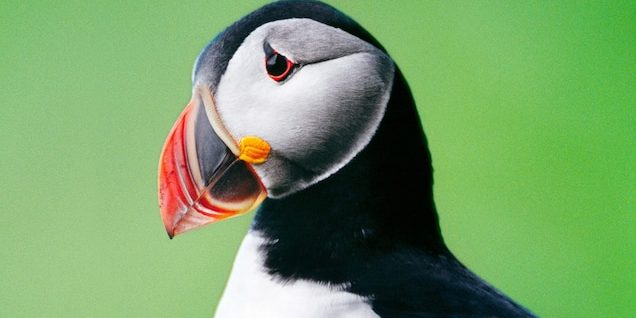Bird of The Week: Atlantic Puffin
SCIENTIFIC NAME: Fratercula arctica
POPULATION: ~193,000 (North America); 6 million (World)
TREND: Decreasing
HABITAT: Breeds on islands in the North Atlantic; winters at sea
The Atlantic Puffin is a small seabird, only a bit larger than a Mourning Dove, but it’s heavy for its size, weighing just over a pound — about the same weight as a full beverage can. It’s the only puffin species found in the Atlantic Ocean; its close relatives the Tufted Puffin and Horned Puffin occur only in the Pacific.
The Atlantic Puffin’s genus name Fratercula means “little brother” or “friar,” probably a reference to its black-and-white plumage and upright posture when perched on nesting islands. Its most distinctive feature — a colorful, triangular, and laterally flattened bill — gives this bird the nickname “sea clown” or “sea parrot.”
These birds wear their most eye-catching colors during breeding season. From roughly March to August, adults sport bold white faces and a blue-gray triangle at the bill’s base that is outlined in bold yellow. Post-breeding, the bill’s colorful outer layers molt off, leaving adults with half-grayish, half-red-orange bills during their winter at sea. The post-breeding molt also grays their distinctive white faces to the color of soot.
Pufflings and Presses
A colony of puffins is known as a “burrow” (after their favored nesting sites); a “circus” (continuing the sea clown theme); or an “improbability” (anyone’s guess). Gray, fluffy juvenile puffins have their own endearing nickname —”pufflings.”
The Atlantic Puffin’s clownish looks endear them to humankind, and thriving tourism industries are built around boat trips to view puffin nesting colonies. Puffins are a popular motif in popular culture. Many offshore islands are named after their puffin inhabitants; the bird appears on the stamps of many countries; and there is even a popular book publishing house named for this bird.
Coldwater Clown
The Atlantic Puffin is a seabird of cold waters, found outside nesting season in the North Atlantic from eastern North America to Iceland and the coasts of northwestern Europe south to Spain. In the United States, the best way to see these small seabirds is to take a boat trip to the rocky islands off Maine where they nest from late April through August. Atlantic Puffins nest in larger numbers in Canada, Scotland, Greenland, Norway, and especially Iceland, which is home to more than half of the global population.
Three subspecies of Atlantic Puffin are recognized, varying mainly in size.
Atlantic Puffins make loud growling calls, usually from their burrows. A colony can sound like herd of cattle lowing, or a bunch of chainsaws revving up.
Fish by the Mouthful
Atlantic Puffins are excellent swimmers and, like others in their group (the family of auks and murres), and Galapagos and King Penguins, use their wings as flippers to dive and swim underwater while chasing prey, usually small forage fish such as herring, sand eels, and capelin. This puffin will also take mollusks and crustaceans, diving as deep as 200 feet while foraging. Unlike penguins, puffins can fly, although their short wings usually preclude the graceful gliding of other seabird species such as the Laysan Albatross.
Puffins swallow their catch underwater unless they’re feeding young; then, they use their specialized bills to carry mouthfuls of fish back to the nest burrow. Puffins have backward-pointing spines inside their bills, on their tongues and on the roofs of their mouths. These tiny structures allow them to hold dozens of slippery fish in place while they pursue and capture more.
Burrowed Time
Atlantic Puffins are monogamous. Each year, pairs reestablish their bonds on their breeding grounds through ritualized behaviors including billing, when a couple rubs beaks together. Although solitary while at sea, nesting puffins are gregarious and gather in large, noisy colonies.
Like many seabirds such as the Pink-footed Shearwater, Atlantic Puffins nest in a burrow, dug by the pair using beaks and feet. Nesting burrows are reused year after year. They usually have a side tunnel that serves as a latrine, plus, at the end of the tunnel, a nest chamber that includes a scrape lined with dry grass and feathers. Sometimes puffins take over a burrow dug by a shearwater or rabbit, or nest in natural crevices or under boulders.
The female puffin lays a single egg, which both parents brood. The pufflings hatch with eyes open and are covered with down. After several months of dedicated parental care, the young leave their nest burrows by night, then take a jaw-dropping leap and plunge from cliff to waters below. Once in the water, they head out to sea, where they continue to mature.
The Atlantic Puffin is a long-lived species, with individuals reaching as old as 30 years of age. Pufflings take several years to become completely mature, and Atlantic Puffins do not breed until they are three to six years old.
In 2019, the Atlantic Puffin was documented as the first tool-using seabird. Watch a video here of a bird using a stick to scratch itself!
Humanity: The Puffin’s Fate is in Our Hands
Puffins are still hunted for food and their feathers in Iceland and on the Faroe Islands. They are also hunted by larger birds such as Great Black-backed Gulls and Great Skuas, and introduced species such as rats, cats, dogs, and foxes.
Atlantic Puffin winters on the open ocean, where it is vulnerable to human-caused dangers such as oil spills. Changes in sea currents and temperatures attributed to climate change have impacted fish stocks, resulting in the collapse and disappearance of puffin colonies. Fisheries pose competition for often-limited food resources, and Atlantic Puffins are sometimes caught and drowned in gill nets.
ABC has developed a free, interactive mapping and information tool to help fishers and fishery managers assess their risk of seabird bycatch and take appropriate measures to minimize or eliminate bycatch in their operations.
SOURCE: American Bird Conservancy (abcbirds.org)


